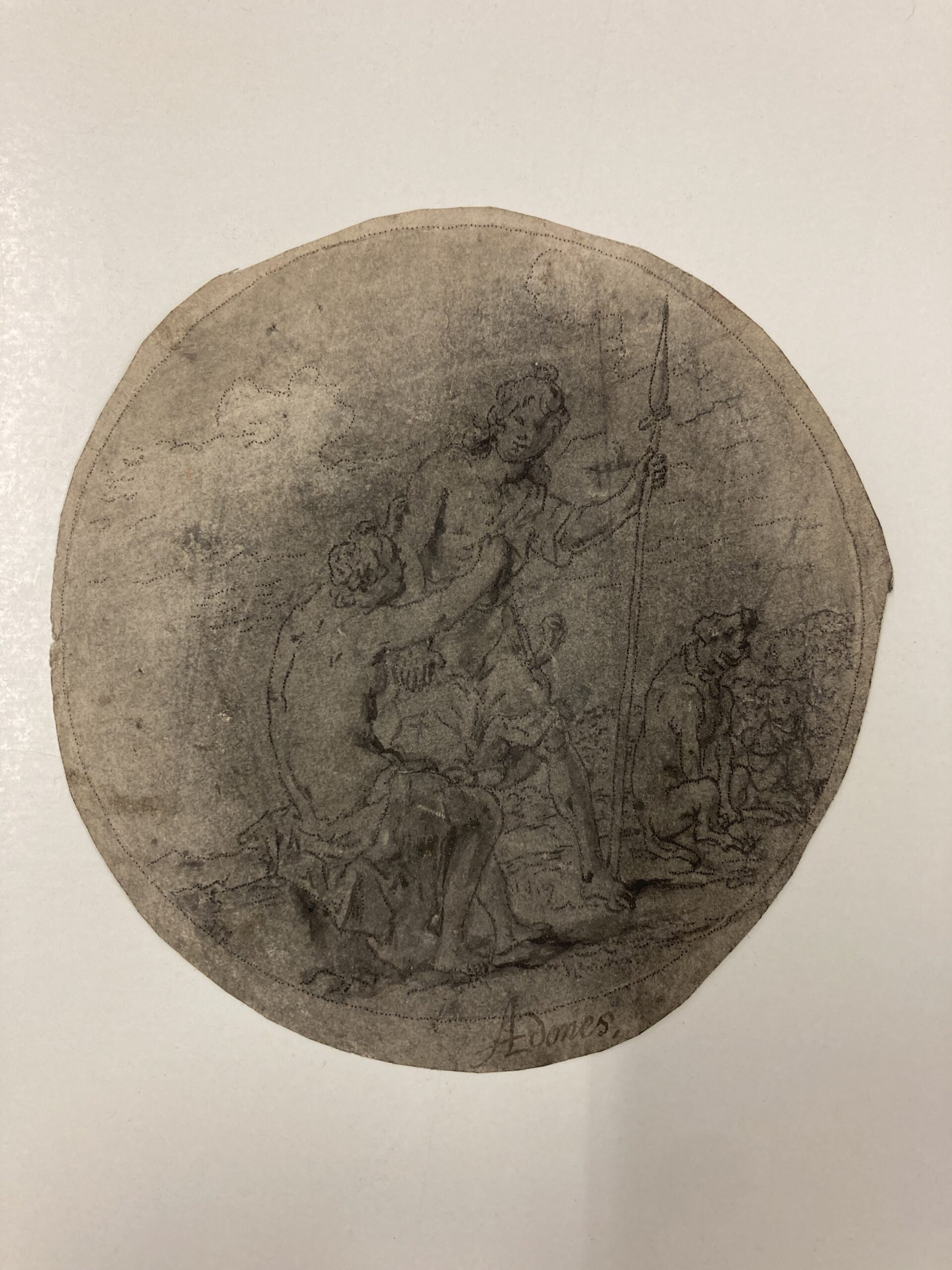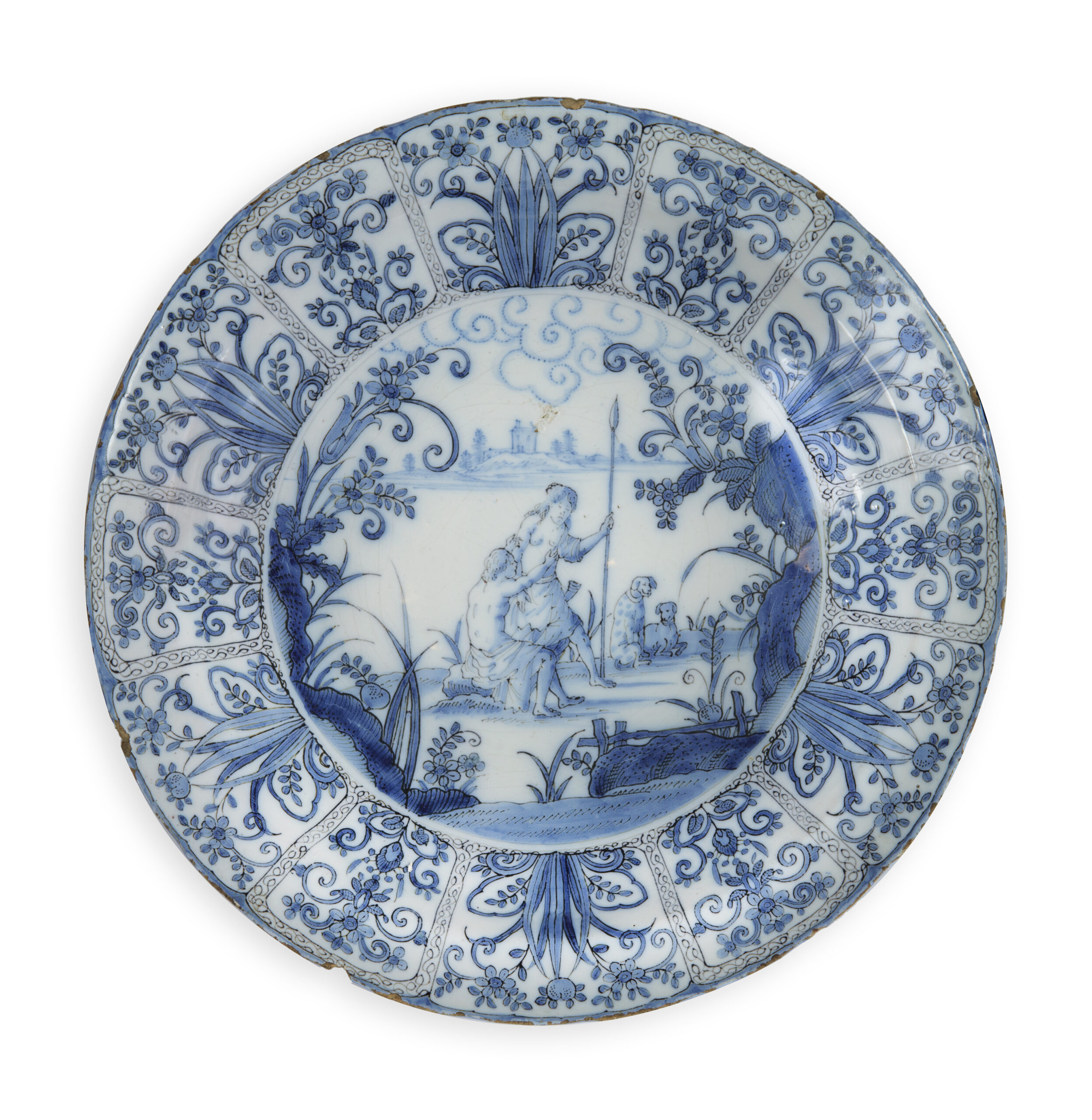[popup_trigger id=”13756″ tag=”span”]![]() [/popup_trigger]
[/popup_trigger]
Images on this website are licensed under a
Creative Commons Attribution-NoDerivs 3.0 Unported License.

’Adones,’ pierced drawing on paper by Leonard Bramer
© Tresoar Archive, Leeuwarden
We acknowledge with great thanks the information shared with us by Ms. Esther van der Hoorn, Prinsenhof Delft and Ms. Femke Diercks, Rijksmuseum Amsterdam
OBJECT
D2203. Blue and White Charger
Delft, circa 1680
Marked IW in blue for Jacob Wemmersz. Hoppesteyn, the full owner of Het Moriaanshooft (The Moor’s Head) factory from 1664 until 1671, and succeeded by his widow Jannetge Claesdr. van Straten through 1686
Painted in blue with carefully delineated ‘zwarte trek’ (outlines in blackish blue) with the scene of Adonis and Venus after a drawing by Leonard Bramer (1596-1674), the cavetto rim with a wide border of fan-shaped floral scrollwork panels.
DIMENSIONS
Diameter: 34.2 cm. (13.4 in.)
PROVENANCE
Collection Maurice de Ramaix (1850-1918), Château de Grune, Belgium, before 1913.
NOTE
Het Moriaanshooft factory was one of the early potteries in Delft, though the date of its founding and its history of ownership is uncertain until 1658/59 when Jacob Wemmersz. Hoppesteyn became part owner. A few years later, Hoppesteyn purchased the remaining company shares as well as the tools and two pottery washing plants, becoming the primary owner of Het Moriaanshooft factory.
Over the next thirty years, the company progressively grew to become a major figure in the history of Delftware. The objects made by Het Moriaanshooft during the ownership of Jacob Wemmersz. Hoppesteyn are amongst the most rare and remarkable of all Delftware production. A document from 1669 states the names of at least nineteen plateelbakkersknechten, potters assistants, aged between 17 and 55 years old who were working for Hoppesteyn.
After Hoppesteyn’s death in 1671, his wife, Jannetge Claesdr. van Straten, assumed the management of the business together with her son Rochus. These pieces are characterized by a very pure glaze of a milk white color. They are elegantly decorated with a cerulean blue. Like the present blue and white charger, few of his pieces are marked by the letters IW, his initials.
In art history, the tragic story of Venus and Adonis has been depicted in various forms, from paintings to sculptures. One notable painting is by Paolo Veronese, completed in 1580, which shows Venus and Adonis in a lush garden. The painting captures the moment when Venus is desperately trying to prevent Adonis from going hunting. The rich colors and intricate details in the painting create a sense of grandeur and drama, while the expressions on the faces of the figures convey the intensity of their emotions.
The story of Venus and Adonis has also been depicted in sculpture, such as the marble sculpture by Gian Lorenzo Bernini, completed in 1622. Bernini’s sculpture shows Venus embracing Adonis as he prepares to leave for the hunt. The sculpture is notable for its intricate details and dynamic composition, which convey the intense emotion and physicality of the figures. Overall, the story of Venus and Adonis has been a favorite subject in art history, allowing artists to explore themes of love, passion, and mortality through the lens of classical mythology. The tragic ending of the story has also provided a powerful metaphor for the fragility of human life and the inevitability of death.
SIMILAR EXAMPLES
An almost identical example from the Krön collection, Paris, with polychrome decoration and gilding was exhibited by Nijstad Antiquairs at The Third International Art Treasures Exhibition, in the Victoria & Albert Museum, in 1962, and illustrated in Aronson 1993, no.2, currently in a Swiss private collection.









